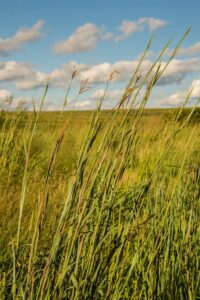Droughts are hard for everyone in agriculture, but can particularly devastating for those in the business of pasturing livestock. Watching pastures dry up and turn brown is terrible, and having pastures that can no longer support the herd puts pasture managers in the position of having to choose whether to cull herds on a depressed drought market or to buy scarce, high-priced hay. Both of these options can be a recipe for financial disaster. Wouldn’t it be nice if it was possible to create pastures that could still produce in a drought?
Two Green Cover customers had experiences in which they had pastures that remained green in the middle of the 2022 drought while their neighbors were all out of feed.

John Williams of Talihina, Oklahoma ,discovered what many others in the pasture business are just now learning. In an area of eastern Oklahoma dominated by endophyte-infected K31 tall fescue, John purchased a farm that had a sparse stand of remnant warm-season native grasses in between brush and timber. John wanted to restore this grass back to a vigorous stand. Through management techniques such as controlled burns and carefully managed grazing, the invigorated warm-season grass stayed green and kept growing while neighboring pastures of fescue simply turned brown and crispy. Warm-season grasses like big bluestem, Indiangrass and switchgrass utilize a different photosynthetic pathway than cool-season grasses like fescue, bromegrass, orchardgrass or Kentucky bluegrass. Warm-season grasses green up later in the spring and go dormant earlier in the fall than cool-season grasses, but when temperatures exceed 90 F, warm-season grasses keep plugging away while cool-season grasses shut down. Warm-season grasses also require less than half the water to produce a pound of feed as do their cool-season counterparts. This summer, in the midst of historic drought, Mr. Williams was able to maintain cattle on pasture while most people who were relying solely on their fescue pastures had to destock.
Ted Lukens, who has a ranch near Medicine Lodge, KS, had a similar experience, but in his case all the region was already in native warm-season grasses. Mr. Lukens success story was a result of managing his native grass with an adaptive managed rotational grazing system featuring daily livestock moves. The average stocking rate for native grass in his area is around 11 acres per cow-calf pair. Ted credits his daily move system with allowing him to nearly double that stocking rate, with a pair for every 6.7 acres, after just three years of intensive management. This year’s intense drought proved to be a test, but his grazing system came through just fine. Throughout south-central and southwest Kansas many were forced to destock, but Ted’s pastures shone. Not only did the pastures carry the herd through the entire season, there was grass left over for use as winter pasture after dormancy.
Adaptive Multi-Paddock Grazing (AMP) uses high livestock densities for short durations between long periods of forage rest to catalyze accelerated grass growth. The system mimics the natural pattern of dense herds of wild ruminants moved frequently by the forces of predation and food availability. AMP grazing may seem like smoke and mirrors, but its success is based on a few scientific principles. One is that most grass plants can tolerate about 50% defoliation without hurting the root reserves or ability to regrow. Once that level is exceeded, the roots begin to die off and the rate of regrowth slows dramatically. In a continuous grazing system, some plants (usually the most palatable species) get repeatedly grazed hard before they are allowed to recover, while other plants are left completely ungrazed. Before long, the overgrazed plants stop producing and the ungrazed and unproductive plants take over. Rotational grazing forces animals to eat all the plants in a paddock uniformly to a predetermined level somewhere less than 50%, with no plants left ungrazed and no plants allowed to be overgrazed. The result is that all the plants in a paddock contribute to animal nutrition, and there can be more total animal product taken from the pasture without harming the grass.
 Every year, we are either in a drought or headed towards the next one. Learning proper rotational grazing management, and the establishment of warm-season grasses in areas where cool-season grasses predominate will enable you to survive and prosper during the next big drought.
Every year, we are either in a drought or headed towards the next one. Learning proper rotational grazing management, and the establishment of warm-season grasses in areas where cool-season grasses predominate will enable you to survive and prosper during the next big drought.
This article first appeared in the 9th Edition of Green Cover's Soil Health Resource Guide.
Also check out the 10th edition, our latest Soil Health Resource Guide, over 90 pages packed with scientific articles and fascinating stories from soil health experts, researchers, farmers, innovators, and more! All as our complimentary gift to you, a fellow soil health enthusiast!